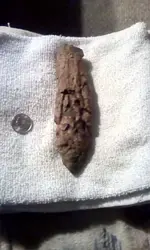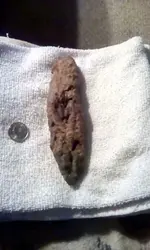Mmoore4813, I'm sorry to see your post has (mostly) gotten a different kind of reception than a new T-Net member should get. Some people forget that we all started out as ignorant beginners.
Here is a serious (non-humorous) answer, which your request deserves. Paraphrasing waht a friend of mine said recently in this forum, looking at heavily rust-encrusted excavated iron objects is like looking at clouds -- you'll see all kind of things in the nebulous forms. You'll need to remove as much of the rust-encrustation as possible, as gently as possible. The Electrolysis rust-removal treatment would be best for that, but because you most probably cannot do Electrolysis (yet), you'll have to try some alternatives.
You could try the vinegar soak first, and if it doesn't do much, then you try another alternative... lightly tap the rust-crust off a little bit at a time, with a hammer. Put the relic on a concrete surface, and gently tap the encrustation, starting at one end of the relic, and move forward a bit at a time as the crust breaks off.
Thank you for putting a coin in the photo alongside the relic. Many newcomers don't think to do that... which makes the job of this forum's relic-ID helpers harder.
At seven inches in length, and apparently pretty much straight for its full length, your relic is too long to be part of a horse-shoe. Perhaps when the "cloaking" rust-encrustation is removed, we'll be able to tell whether your relic is a boken-off piece of a larger object... or is intact. For example, it MIGHT be a railroad spike, or somethig similar.
Welcome to TreasureNet's "What Is It?" forum, the best place on the internet to get unknown objects correctly identified. May you have good fortune in your metal-detecting efforts. Please do not be discouraged. I hope we'll hear more from you. As I said, we all start out as ignorant beginners. Keep on hunting, and learning,









